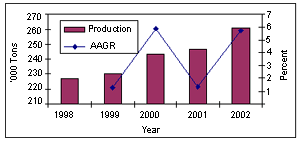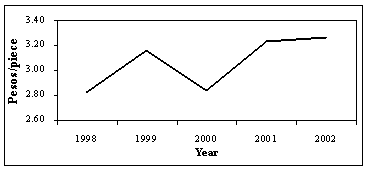

Chicken Egg: The Belittled Industry(1)
Marie Annette S. Galvez
Agribusiness Specialist
Center for Food and Agri Business
University of Asia and the Pacific
The Philippine layer sector (chicken egg) has played a minor role in the poultry industry. It is not proverbial like the broiler sector (chicken). Although, the latter accounted for 75% of the poultry industry, the layer sector registered the highest growth of 13% between 2001 and 2002. This is attributed to the increase in the number of chicken layers.
The layer sector is composed of small, medium and big farms. Small layer farms are those with population of less than 10,000 birds, medium farms have 10,000-80,000 birds and large farms have more than 80,000.(2) Under the name National Federation of Egg Producers of the Philippines or Egg Board, egg farmers have organized themselves seeing the need to be united and to strengthen their cause. In a span of four years, membership has extended to egg growers from key production areas with combined layer population of 15 million. Moreover, it has organized two egg shows and has crafted a master plan, among others.
Boons and Bounties
Based on Bureau of Agricultural Statistics' agriculture performance for 2002, the layer sector contributed about P17 billion at current prices or 3% to total value of agriculture in 2002. In terms of volume, production reached 5.5(3) billion pieces in the same year. It employs about 90,000 persons from farmhands, managers, traders, and market-vendors to transit/store helpers.(4) Meanwhile, domestic supply, which primarily serves the local market, comes from commercial and native chicken. The former accounts for about 70% of total table egg production while the latter for 30%.
Chicken eggs are one of the cheapest and excellent sources of protein. Apart from being easy to prepare, eggs are a valuable source of iron, phosphorous, Vitamin B12 and other nutrients. A detailed list of the contents of a 50-gram egg is shown in Table 1.
| Nutrient | Amount | Nutrient | Amount |
|---|---|---|---|
| Energy | 297 kJ | Zinc | 0.5 mg |
| Protein | 6,300 mg | Phosphorus | 109 mg |
| Fat | 5,000 mg | Vitamin A | 144 mg |
| Carbohydrate, total - sugars |
200 mg 200 mg |
Thiamin (vitamin B1) | 0.04 mg |
| Riboflavin (vitamin B2) | 0.21 mg | ||
| Cholesterol | 185 mg | Niacin (vitamin B3) | 1.0 mg |
| Sodium | 66 mg | Vitamin E | 0.8 mg |
| Potassium | 57 mg | Folate | 12.4 µg |
| Iron | 0.8 mg | Vitamin B12 | 0.5 µg |
Source: Australian Egg Industry Association
Further, egg preparation is one of the most versatile. It can be boiled, poached, scrambled or combined with other ingredients. Egg products also come in various forms - refrigerated liquid, frozen, dried, specialty and consumer - which are for commercial, food service and home use.
Important Indicators
Production. Output managed to increase by 3.6% p.a. to 260,820 tons in 2002 from 227,000 in 1998. Luzon is the major producing area, accounting for 60%, with Bulacan, Batangas and Rizal as the leading provincial sources.
Figure 1. Production and Growth Trends of Chicken Eggs, Philippines, 1998-2002

Note: AAGR - Average Annual Growth Rate
SOURCE: BAS
Trade
The Philippines exports a minimal amount of egg-products, i.e., egg albumen. Likewise, importation is an insignificant portion of supply. Aside from chicken eggs, the country imports products like egg powder, dried egg yolk and other than dried egg yolk. From 1998 to 2002, volume of imported chicken eggs grew by 12% yearly. Meanwhile, imports of egg powder, dried egg yolk and other than dried egg yolks increased by 22%, 140% and 19% p.a., respectively.
In 2002, the only supplier of fresh/preserved/cooked chicken eggs was India. On the other hand, egg powder, dried egg yolk and other than dried egg yolk came mainly from USA, Belgium and Denmark, respectively.
| Year | With Shell, Fresh Preserved/Cooked | Egg Powder | Egg Yolk, Dried | Egg Yolk, Other than Dried | ||||
|---|---|---|---|---|---|---|---|---|
| Volume | Value | Volume | Value | Volume | Value | Volume | Value | |
| 1998 | - | - | 86.94 | 385.73 | 78.09 | 245.01 | 297.09 | 732.55 |
| 1999 | 233.35 | 76.98 | 189.40 | 581.43 | 91.39 | 364.44 | 319.36 | 576.09 |
| 2000 | 330.16 | 95.30 | 246.22 | 505.96 | 363.94 | 608.55 | 279.43 | 419.27 |
| 2001 | 545.12 | 14.88 | 373.61 | 799.79 | 210.25 | 607.02 | 405.19 | 632.26 |
| 2002 | 155.63 | 18.11 | 311.42 | 584.40 | 555.52 | 1,721.81 | 508.49 | 954.90 |
Note: Volume in thousand pieces (with shell) and tons (egg
powder and egg yolk); Value in $ 000 CIF
Source: National Statistics Office
Prices
Table eggs are sold according to size - small, medium, large and assorted or unclassified. Retail prices of medium-sized chicken eggs in Metro Manila increased by 4% p.a. from P2.84/piece in 1998 to P3.26/piece in 2002 (Figure 2).
Figure 2. Retail Price Trends of Chicken Eggs, Metro Manila, 1998-2002

Source: BAS
A Challenging Task
One of the biggest issues that beset the chicken egg industry is the low domestic consumption. A cross country comparison cited in the layer master plan indicated that the Philippines has a per capita consumption that is similar with Indonesia of 51 eggs/year but far lower than Thailand of 130 eggs/year and China, 300 eggs/year. Moreover, the Philippines ranked 20th among Asian countries in terms of per capita consumption.
The sector is threatened by the perception that chicken eggs cause high cholesterol levels. This idea has thwarted the local demand of table eggs. Also, it is believed that a maximum of only three eggs should be consumed every week. On the contrary, recent research(5) discloses that an egg a day is beneficial. The Egg Board regards the situation as a challenge. It commits to work in order to double or triple egg consumption in the next few years.
With the help of the Department of Agriculture, the Egg Board has started its multi-media campaign by radio and TV commercials to educate consumers on the benefits of eggs and correcting the misconception. A Marketing Committee has also been formed last year, which conducted Egg Feeding Programs in seven provinces. It promotes egg consumption by feeding students and informing the teachers of the benefits.
The layer sector may have a long way to go but a unified effort of the egg growers shows a lot of promise.
References:
The 1st Philippine Egg Show Directory, 2001
The 2nd Philippine Egg Show Directory, 2002
Layer Master Plan, 2002
1. * This industry brief was published by the Manila-based University of Asia & the Pacific, Center for Food & Agribusiness in the February 2003 issue of the Food & Agribusiness Monitor, primarily for a Philippine audience. This industry brief is being made available to Canadian businesspeople in order to provide basic market information should there be export interest in relevant agrifood commodities.
2. 1 Layer Master Plan, 2002
3. 2 Bureau of Agricultural Statistics (BAS); Conversion rate of chicken eggs is 21 pieces to 1 kg
4. 3 Department of Agriculture, 1999
5. 4 Australian Egg Industry Association, September 2001
| Date Modified: 2003-06-16 | Important Notices |